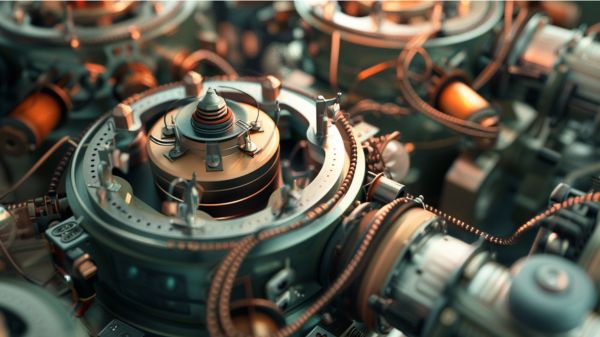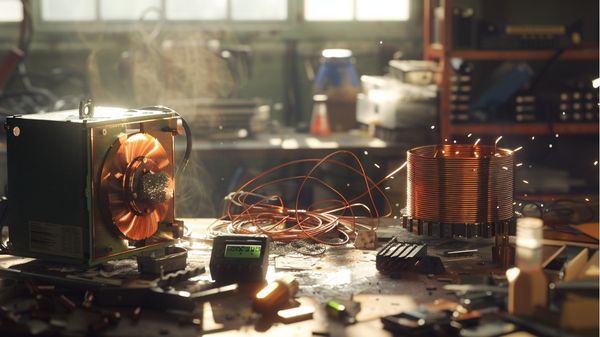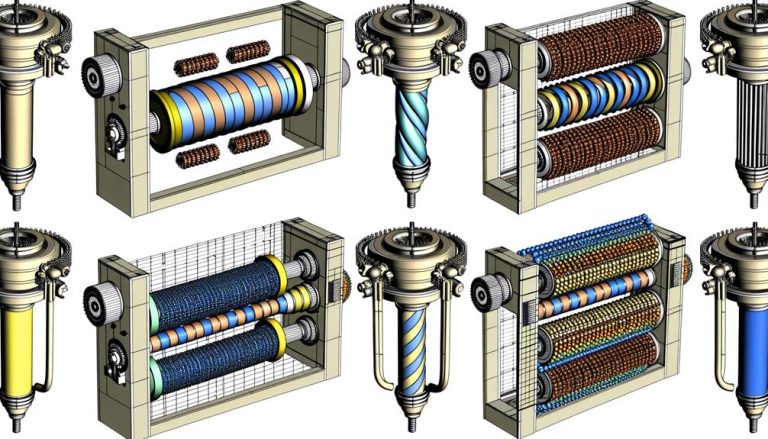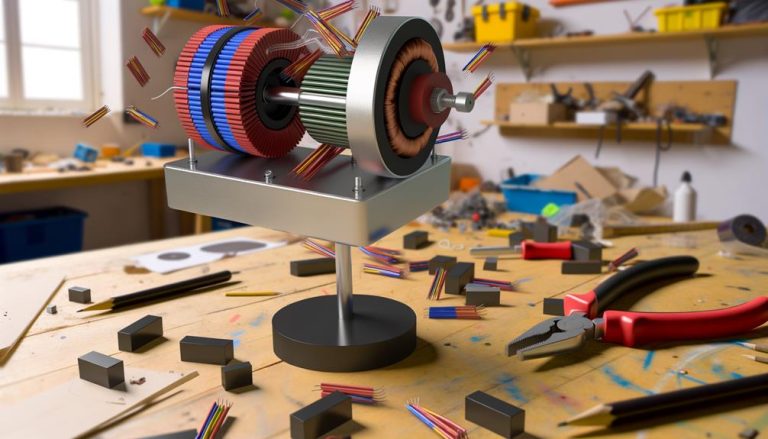Have you ever wondered how magnets can generate power? The science behind generating power with magnets is quite fascinating. By harnessing the power of electromagnetic induction, magnets can transform kinetic energy into electricity.
But how does this process actually work? And what role do magnets play in renewable power generation?
In this discussion, we will explore the intricate relationship between magnets and electricity, uncover the applications of electromagnetic induction, and delve into the limitations of magnetism as a sustainable energy source.
Get ready to uncover the secrets behind generating power with magnets and discover the potential they hold for the future of energy production.

Key Takeaways
- Magnetic fields interact with conductors to produce electric current.
- Electromagnetic induction creates electromotive force in electric conductors.
- Electric generators and motors utilize electromagnetic induction for energy conversion.
- Magnets play a vital role in renewable power generation for consistent and sustainable energy supply.
Magnetic Fields and Electricity
When discussing the science behind generating power with magnets, it’s essential to understand the relationship between magnetic fields and electricity. This relationship is established through electromagnetic induction, a fundamental process by which magnets generate electricity.
A magnetic field, created by a magnet, interacts with conductors to produce an electric current. This interaction occurs when there’s a changing magnetic field near a conductor, causing the electrons within the conductor to move, creating an electric current.
This discovery was made by Michael Faraday through his experiments, which demonstrated the direct link between magnetic fields and electricity. The ability of magnets to generate electricity is a result of this conversion process, where magnetic energy is transformed into electrical energy.
Understanding this relationship is crucial in harnessing the power of magnets to generate electricity efficiently.
Electromagnetic Induction
Electromagnetic induction is a fundamental process that creates an electromotive force (EMF) in an electric conductor through the interaction of a changing magnetic field. This process was first demonstrated by Faraday in his 1831 experiment, where he showed that moving magnetic fields induce electric currents.
The key to electromagnetic induction lies in the interaction between the magnetic field and the electric conductor. When a magnetic field interacts with the loosely held electrons in a conductor, it creates a force that causes the electrons to move, generating an electric current.
However, it’s important to note that motion is required for electromagnetic induction to occur. A stationary magnet alone can’t produce an electric current through induction.
Applications of Electromagnetic Induction
The practical applications of electromagnetic induction span a wide range of industries and technologies. One of the most significant applications is in electric generators. These devices use electromagnetic induction to convert mechanical energy into electrical energy, making them a crucial component of electric power plants.
Electric motors, on the other hand, rely on electromagnetic induction to convert electrical energy into mechanical energy, enabling various machines and appliances to function. Transformers also utilize electromagnetic induction to change voltage levels in alternating currents, allowing for efficient transmission and distribution of electricity.
Faraday’s experiments paved the way for understanding how magnets generate electricity through electromagnetic induction, leading to the development of these applications. From wind turbines to the use of permanent magnets, electromagnetic induction plays a vital role as an energy source and topic in multiple industries.
Role of Magnets in Renewable Power
Magnets play a vital role in renewable power generation, converting kinetic energy into electricity through their unique properties. Here is how magnets contribute to the production of renewable power:
- Wind turbines: Magnets are used in wind turbines to convert the kinetic energy of wind into electrical power. As the wind blows, it causes the turbine blades to rotate. The rotation is then transferred to a generator that contains magnets. The movement of these magnets within a coil of wire generates an electric current.
- Hydroelectric power plants: Magnets are also utilized in hydroelectric power plants to generate electricity from the kinetic energy of flowing water. The water flow turns the turbine, which is connected to a generator. Inside the generator, magnets are rotated by the turbine, producing electrical energy.
- Efficiency and reliability: Magnets are crucial components in modern energy systems that rely on renewable sources. They contribute to the efficiency and reliability of electricity generation, ensuring a consistent and sustainable power supply.
Limitations of Magnetism as a Renewable Energy Source
Limitations arise when considering magnetism as a standalone source of renewable energy due to the Law of Conservation of Energy. While magnets play a crucial role in the conversion of kinetic energy into electricity in various power generation methods, they aren’t standalone sources of renewable energy.
Electricity generation using magnets requires the conversion of kinetic energy into electricity, which is then utilized to power various devices. Mainstream power generation methods, including renewables, utilize magnets for energy conversion. However, magnetism alone can’t generate electricity without an external source of energy.
The Law of Conservation of Energy states that energy can’t be created or destroyed, only converted from one form to another. Therefore, magnetism can contribute to renewable energy generation, but it can’t be the sole source of renewable energy, given its limitations in energy conversion.
Frequently Asked Questions
Does Magnetic Energy Generator Really Work?
Yes, magnetic energy generators can work, but their efficiency analysis reveals advantages and disadvantages. Consider the environmental impact, magnet strength requirements, cost effectiveness, maintenance considerations, potential applications, magnetic field manipulation, magnet materials and their properties, and future advancements.
How Does Electricity Flow Through Magnets?
Electricity flows through magnets when a changing magnetic field induces current in a conductor. This occurs due to the interaction between magnetic fields and conductors, allowing electrons to move and creating an electric current.
Can a Magnet Produce Electricity on Its Own?
No, a magnet cannot produce electricity on its own due to the Law of Conservation of Energy. However, magnets play a crucial role in converting kinetic energy into electrical energy in various power generation technologies.
How Do Magnets Induce Voltage?
When magnets induce voltage, they create a changing magnetic field around a conductor. This causes electrons to move, generating an electromotive force. Faraday’s Law of Electromagnetic Induction explains this process, which is essential in power generation.

Conclusion
The science behind generating power with magnets lies in electromagnetic induction. This process involves the interaction between magnetic fields and conductors, converting kinetic energy into electricity.
Magnets serve as the catalyst for efficient energy production in various power generation methods, including mainstream sources like wind and hydroelectric power. However, it’s important to recognize the limitations of magnetism as a renewable energy source.
Like a guiding compass, magnets play a vital role in our energy landscape, directing us towards a more sustainable future.




